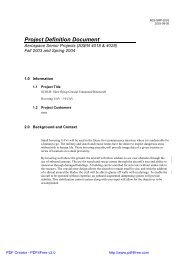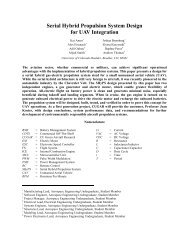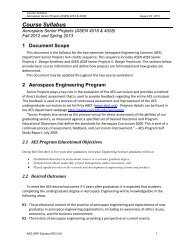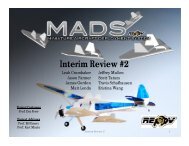PFR - Aerospace Engineering Sciences Senior Design Projects ...
PFR - Aerospace Engineering Sciences Senior Design Projects ...
PFR - Aerospace Engineering Sciences Senior Design Projects ...
Create successful ePaper yourself
Turn your PDF publications into a flip-book with our unique Google optimized e-Paper software.
Project Final Report – CUDBF April 30 th , 2009<br />
ASEN 4028: <strong>Aerospace</strong> <strong>Senior</strong> <strong>Projects</strong><br />
Static Margin<br />
0.2<br />
0.15<br />
0.1<br />
0.05<br />
0<br />
-0.05<br />
-0.1<br />
-0.15<br />
Static Margin as a function of Taper Ratio and Sweep Angle<br />
Sweep Angle of 25 o<br />
Sweep Angle of 20 o<br />
Sweep Angle of 15 o<br />
Sweep Angle of 10 o<br />
Sweep Angle of 5 o<br />
-0.2 Sweep Angle of 0 o<br />
-0.25<br />
-0.3<br />
1 2 3 4 5 6 7 8 9 10<br />
Taper Ratio * 10 -1<br />
Figure 12: Determining Wing Geometry<br />
The leading edge sweep angle was narrowed down to between 15 degrees and 25 degrees such<br />
that a positive static margin was assured. The choice of configuration is discussed in the<br />
Mechanical <strong>Design</strong> Elements section for aerodynamics.<br />
5.1.2 Airfoil Selection<br />
In order to choose the best suited airfoil for a flying wing configuration, several hundred airfoils<br />
on the UIUC database as well as the DBF Osborne databases were analyzed. All the airfoils<br />
were plotted in the airfoil analysis tool XFOIL [8] . The three best airfoils were chosen based on<br />
their drag polars and variance in coefficient of moment with angle of attack. The main driver for<br />
the airfoil selection was the coefficient of moment as a function of angle of attack. Since the<br />
configuration chosen for this aircraft is a flying wing design, the longitudinal static stability of<br />
the aircraft is very important. Flying wings have the tendency to be unstable in pitch; therefore,<br />
selecting an airfoil with optimal lift characteristics as well as a coefficient of moment very close<br />
to zero was extremely important.<br />
The variation in moment coefficient with angle of attack and the variation of the lift coefficient<br />
with angle of attack for the three best airfoils are shown in Figure 13. The top three airfoils<br />
shown are the HS520, Eppler216 and the HS602.<br />
32
















